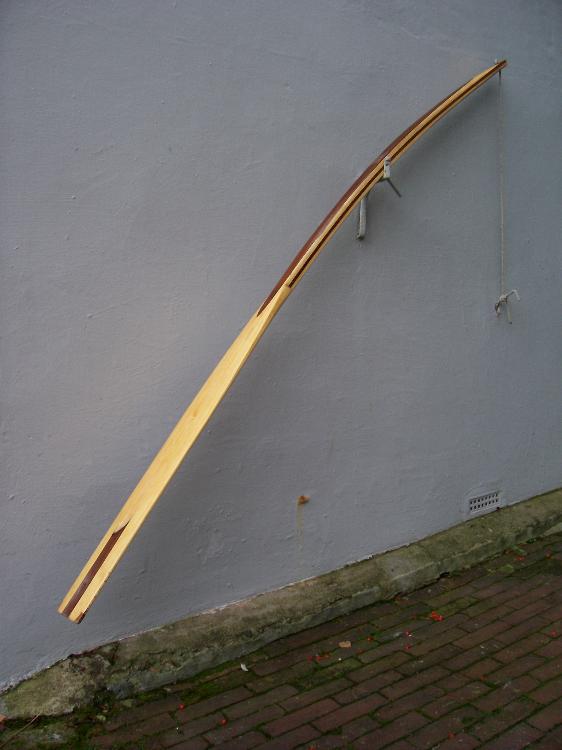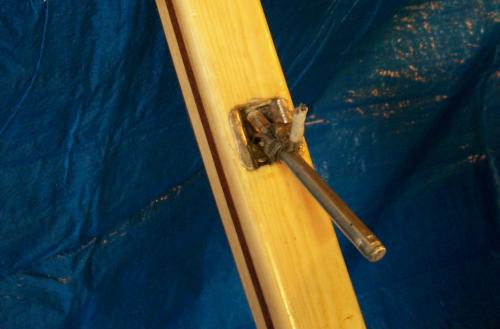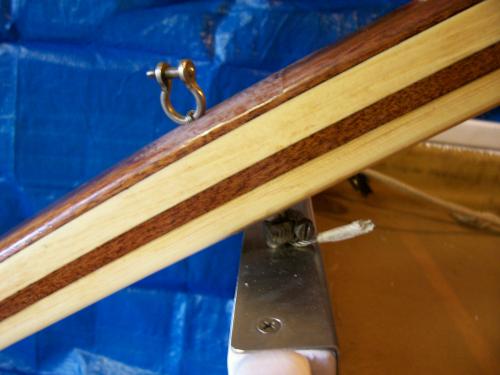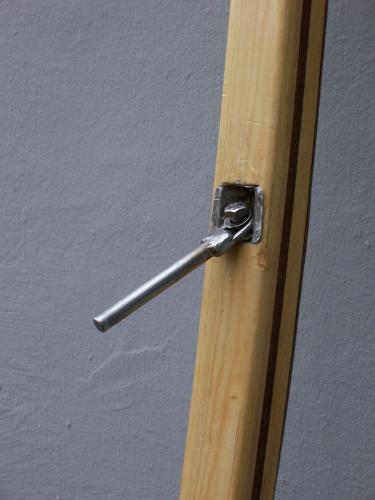Yuloh
|
|
This post was updated on .
So this, er pedal powered yuloh; the Ped-Yuloh as our Phil (Oxborrow) has dubbed it. After a surprising initial success mocked up with an oar shoved up a piece of bent alloy pipe, I was emboldened to take to my workshop and produce an imitation of the real thing. While not actually a mistake, my questionably beautiful craftsmanship doesn’t really seem to work as well as an old oar shoved up a pipe. However, it does produce a modicum of genuine motive power under pedal. The oar might have done, but on a mere nine foot dinghy it came to a disagreement with the back of my head and there was insufficient room to separate the two.
For those who missed the beginning of this conversation, I would explain that there is a small but friendly HBBR rift between the oarsmen and the paddlers and as one of the former I am perennially jealous of the canoeists’ ability to sneak up on kingfishers and the like and generally see where they are going. I would like to face forward, while sitting comfortably, in a sufficient size of boat to be lived in rather than worn, while on our HBBR river raids where sites for tents can be less than plentiful. So I had an idea. Here is an explanation of a yuloh – a type of sculling oar invented by the Chinese: 1. Imagine an oar with a moderately curved loom, concave downwards and a socket in the underside that fits loosely over a stud on the stern of the boat. 2. From the handle to an eye vertically below it on the boat, there is a tether long enough to allow submersion of the blade, which lies across the flow. The dynamics are such that by simply swinging the oar from side to side it rotates sufficiently at each stroke to induce an angle of attack at the blade, causing forward pressure as it moves from side to side. This eliminates the considerable effort involved in using a single straight oar in a rowlock, or notch, where the handle must be constantly pulled against the forward pressure of the blade and manually rotated at each stroke. What a relief; it becomes a piece of cake and I'm really, really irritated it has taken me six decades to find out. Before this, having watched Tim O’Connor pedalling his canoe with a Hobie Mirage drive, I simply got to wondering how you might use your legs to do the work without paying Mr Hobie’s prices. I had also been peering down the inside of Graham Neil’s canoe and admiring the simplicity of his pedal steering; so after considerable racking of the grey matter reckoned on a line from each side of a yuloh, turned through blocks so that you could sit facing forward between them, put loops in each end over your feet and kick forward with alternate legs in a pedalling action. There is actually nothing new under the sun and after I had started down this line of thought, I was checking out yuloh design and came across a series of Yahoo messages. Look up Michalak message10468 in which another band of brothers comes to pretty much the same conclusion. However having arrived, they go seriously technical about how the pedals might work, then one of them promises to go off and try it and there the trail goes cold. You need pedals; legs are far too heavy to be held up in the air for any length of time. My pedals are pretty simple though – a couple of very small swings under a bar resting on the gunwales. Watching the mocked up Yuloh behave itself, at the time and again on Graham's video (Port-na-Storm blog of Sunday 7th November), I was beginning to reckon that the curve of the shaft is not so critical as long as there is some. What matters is the ability to control the pitch of the blade. Mine was accidentally limited at rather over thirty degrees to athwartships each way and thirty degrees is apparently about the maximum you can turn a rudder blade before it stalls out. I spent a couple of weeks spare time laminating, (for me amazing) curves into my yuloh. I even found, sharpened and applied to the wood, my dear old Dad’s spoke shave. Why he had one I know not, it’s an instrument I never saw him use, though he swears he did on occasion.  I tried my Yuloh out on the river here recently and there are major problems – firstly the laminated curved loom should be less so; rather than just cocking to an angle of attack, it tried to roll vertical at each stroke if any real energy was applied to the system. The notch in the loom, for the pivot was lined with a small stainless indent, carefully designed to stop at 30 degrees each way and the over-rotating just meant that the oar threw itself off the pivot if there was enough power to make the stroke worth while. I spent a good while fending myself off the boats moored on the lee-side of the river. My mind had been working on all these exciting little imperfections overnight and the next morning I thought I might have come up with a pivot-trap for overly-cocky notches, though it would have been nice if it hadn’t been trying so hard. I fixed a short piece of halyard wire through the loom and notch and jubilee clipped it to the pivot. This did actually work adequately, but I could see that after some twenty minutes I only had perhaps another ten minutes worth of strands to go.   Back to the drawing board. The system has to be properly captive, so I retreated to the recesses of my onboard think tank. In there I found an old notion of a hexagonal head, stainless coach bolt, with an inch or so of smooth shank; also a small shackle. If you weld the shackle to the head of the pivot pin then insert the screw, which fits loosely, through the hoop and angle it into the back of the notch and thence to the oar loom and epoxy it all up, then nobody is going to leave the party without considerable effort – hopefully more than is required to make the oar scull for you, which it does with a sort of sulky deference.   Why the reluctance? It’s a very good question; initially at least it did not provide the power of the original oar and pipe arrangement. These are the reasons I have come up with so far. The bend of the oar loom (shaft) may be more critical than I thought. Not so much the depth of the bend, but its location – it should all be inboard of the pivot. The initial ‘masterpiece’ has a curve throughout its length and if you set it up on dry land and watch the blade, keeping it central while flipping it from one angle to the other it actually performs a shallow ‘U’ shape with a diameter of perhaps as much as fifteen inches. If it does that at each end of a stroke, then that is thirty inches of wasted push. Next the angle of attack is greater on the mock-up and I think forty-five degrees would probably not be excessive. Finally, the coach screw is apparently not absolutely central, giving a greater angle on one side than the other – a waste of good stroke. In fact I was fortunate on the first outing to have only tied up the lines with rolling hitches which I was able to slide around, altering the length, thus angling the oar off centre to correct the problem. You can actually steer, in broad sweeps only, by pedalling deeper and harder with the leg on the outside of the curve. It does occur to me that if the pivot pin was mounted on the top aft corner of a rudder stock and there was some bungied control of the tiller, it would reduce the minor reverse wagging effect of this particular tail. The only reason for mentioning this is that I thought about using a rudder anyway and even a centreplate to stop lateral drift. All getting a bit complicated, isn't it? However it should allow me to see the kingfishers that I have hitherto missed. And on the first real outing I did – see one. It must have been deaf of course; the 'clonk' as the blade changes angle at each stroke reverberates through the GRP hull which acts like a megaphone announcing my approach to all and sundry; grave stones have been noticed to shift. It's so loud I'm thinking of selling it to Nissan as an alternative to the turbine noise they use on their latest electric car, or maybe to Disney as a sound track for the approaching Captain Hook. The other noise is a slow repulsive creak form the wood and rope pedals, like something rather unpleasant going on in the orlop deck of HMS Victory. Peace in our time? Finally I managed to shorten the handle inboard, set up a suitably fixed seat and all the other tiddley little irritations that beset an experiment and give it a go in front of an audience: Much to my surprise, it overcame a moderate breeze and the usual sturdy little tide making its way past Dell Quay, so I guess it has proved a point, though I don’t suppose it will ever break any records and don’t ever expect to see a nine foot dinghy planing under pedal. Chris Waite |
|
|
Chris had problems embedding the You Tube video...here it is and I love the sound track!
PS: The trick is to copy the entire text after pressing the Embed button below the video on You Tube. Then press the Nabble Embed button and paste between the embed tags. -Paul |
|
|
In reply to this post by Chris Waite
On 10 Jan 2011 at 10:42, Chris Waite [via UK HBBR Forum] wrote:
> Mine was accidentally limited at rather over thirty degrees to > athwartships each way and thirty degrees is apparently about the > maximum you can turn a rudder blade before it stalls out. > However, when you start moving forward the apparent angle of attack reduces and it would be desirable to increase the rotation to maintain the same thrust. -- Hoping for calm nights Alastair Law, Yeovil, England. <http://www.little.jim.freeuk.com> |
|
|
In reply to this post by Paul H (admin)
On 10 Jan 2011 at 12:06, adminHBBR [via UK HBBR Forum] wrote:
> > > Chris had problems embedding the You Tube video...here it is and I > love the sound track! > > <nabble_embed></nabble_embed> > > PS: The trick is to copy the entire text after pressing the Embed > button below the video on You Tube. Then press the Nabble Embed button > and paste between the embed tags. It's a good trick! You can see, above, what I received. -- Hoping for calm nights Alastair Law, Yeovil, England. <http://www.little.jim.freeuk.com> |
|
|
Hi Al,
On 10 Jan 11 20:34 "alopenboat [via UK HBBR Forum]" <[hidden email]> said: > > It's a good trick! You can see, above, what I received. Videos are only for those visitng the web site! Mail subscribers don't see it, but they can by clicking the VIEW MESSAGE link in the footer of the post. Then they'll see the post on the site and will see the embedded video. Greg Chapman http://www.gregafloat.plus.com A Boating Biography http://www.seahawk17.plus.com Celebrating the SeaHawk!
Greg Chapman
GregAfloat - My Boating Biography |
|
|
In reply to this post by Chris Waite
Here's the video from the Dell Quay meet, also showing George Isted's very nice Pup. |
|
|
In reply to this post by GregHBBR
On 10 Jan 2011 at 12:54, GregHBBR [via UK HBBR Forum] wrote:
> > > Hi Al, > > Videos are only for those visitng the web site! > > Mail subscribers don't see it, but they can by clicking the VIEW > MESSAGE link in the footer of the post. Then they'll see the post on > the site and will see the embedded video. Not even a link, like we get for pictures? -- Hoping for calm nights Alastair Law, Yeovil, England. <http://www.little.jim.freeuk.com> |
|
|
This post was updated on .
Apparently not! I'm still investigating but it seems that the "nabble_embed" feature only works for: * Videos from Youtube and LiveLeak * Polls from Polldaddy.com (flash polls only) So the ability to show video directly within the forum is limited. For others you could only provide a link to the site where it has been uploaded.
Greg Chapman
GregAfloat - My Boating Biography |
|
|
In reply to this post by Chris Waite
A few questions:
How much curve should a Yuloh have? "bulge factor" is the best way to describe a curve - the maximum offset from a straight line joining the ends divided by the length of the line. Also the percentage distance of the bulge from an end (50% for a circular arc) Is the cross section of the blade important? cheers Paul |
|
|
On 10 Jan 2011 at 15:46, adminHBBR [via UK HBBR Forum] wrote:
> > > A few questions: > > How much curve should a Yuloh have? As the thrust is perpendicular to the blade it would presumably be best to have the blade vertical in the water. The geometry of the craft often makes this impossible. The curve on the Paradox blade is such that it stows comfortably along the side deck. This may be a coincidence. > "bulge factor" is the best way to describe a curve - the maximum > offset from a straight line joining the ends divided by the length of > the line. Also the percentage distance of the bulge from an end (50% > for a circular arc) The Paradox plans simply call for a 30mm curve. When laminating the yuloh I placed the ends on 30mm blocks and weighted the middle till it touched the ground. > Is the cross section of the blade important? Yes, in the same way as the shape of a sail is important. You can make a passable sail from a flat sheet of pollytarp. If you want that extra half knot then you go to a sailmaker and get a properly shaped sail. For a falling leaf stroke, like Chris is using, the blade is best if it is flat on the top (trailing) surface and symmetrically cambered on the bottom (leading) surface. -- Hoping for calm nights Alastair Law, Yeovil, England. <http://www.little.jim.freeuk.com> |
|
|
Not only does the speed of the vessel make a difference Al, but so does the speed (sideways) of the blade and for a given (leg) power, that depends on speed and resistance. I gave up trying to work it out, but it reminds me of a favourite Limerick:
There once was a gay from Khartoum Took a lesbian up to his room They spent all the night Arguing who had the right To do what and with which and to whom On the subject of what you can and can’t do (electronically) in the Forum, while I am quoting stuff, here’s one from RJ (Spitfire) Mitchell to a test pilot: “If anybody ever tells you anything (about an aeroplane) that is so complicated you cannot understand it; take it from me, it’s all balls”. Come on you naughty nerds, this is a boat forum. Next quote from Einstein: “Any intelligent fool can make things more complex, it takes a touch of genius and a lot of courage to go in the opposite direction”. “The internet is a very fine tool, but it makes a very impoverished 'Raison d’ etre'. Apart from anything else, you can’t eat it” – that’s me. Now, theoretically the blade should be flat on the back (top) and gently curved on the front (underside). My blade is a little like this up towards the handle becoming slightly, but similarly curved both sides at the tip. To make the ideal shape work would require even more concentration on angle of attack and I don’t think it is worth the biscuit. From what I can tell, the curve of the loom as I explained, needs to be all inboard of the pivot and I now have perhaps 75 mm maximum on an oar of perhaps 2300 mm. However, this measurement depends on how far through the loom your actual fulcrum effect takes place. The reason for the curve is to ensure that the blade rotates prior to the stroke and any curve outboard only serves to reduce the stroke width by increasing the turning curve of the blade at each rotation. My pivot is about 700 mm from the tip of the handle; just under a third of the way along. Controlling excess angle of attack seems paramount. Why these measurements? Because that’s where they all ended up after I had finished squeezing the maximum out of the available wood, then cutting the handle back to make room for me in the boat without banging my feet against the forward buoyancy tank. Chris W |
«
Return to General Discussion
|
1 view|%1 views
| Free forum by Nabble | Edit this page |

